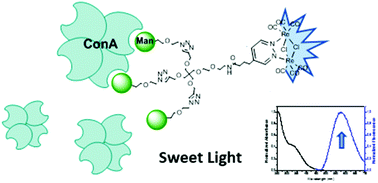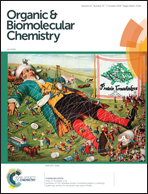Glycodendron–rhenium complexes as luminescent probes for lectin sensing†
Abstract
The design, synthesis and characterization of novel glycoconjugate luminescent probes based on dinuclear rhenium(I) complexes are reported. A multivalent platform bearing different carbohydrate moieties (Glc, Gal and Man) was used to target carbohydrate-binding proteins (lectins), exploiting the unique photophysical characteristics of a Re(I) luminophore for protein sensing. Our results show that these glycoconjugates, non-luminescent in aqueous medium, are able to specifically bind different lectins (ConA and PNA) with a consequent enhancement of emission intensity. These findings suggest the use of Re(I)-based glycoconjugates as switch-on luminescent probe tools in biological applications.

- This article is part of the themed collection: Chemical Biology in OBC


 Please wait while we load your content...
Please wait while we load your content...